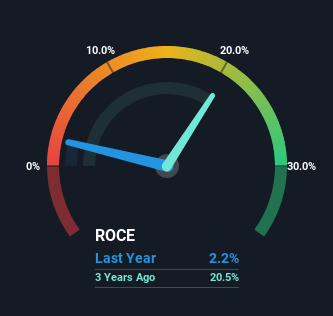- China
- /
- Electronic Equipment and Components
- /
- SHSE:688522
Capital Allocation Trends At Naruida Technology (SHSE:688522) Aren't Ideal
There are a few key trends to look for if we want to identify the next multi-bagger. Ideally, a business will show two trends; firstly a growing return on capital employed (ROCE) and secondly, an increasing amount of capital employed. If you see this, it typically means it's a company with a great business model and plenty of profitable reinvestment opportunities. However, after investigating Naruida Technology (SHSE:688522), we don't think it's current trends fit the mold of a multi-bagger.
Understanding Return On Capital Employed (ROCE)
For those who don't know, ROCE is a measure of a company's yearly pre-tax profit (its return), relative to the capital employed in the business. Analysts use this formula to calculate it for Naruida Technology:
Return on Capital Employed = Earnings Before Interest and Tax (EBIT) ÷ (Total Assets - Current Liabilities)
0.022 = CN¥50m ÷ (CN¥2.3b - CN¥131m) (Based on the trailing twelve months to March 2024).
So, Naruida Technology has an ROCE of 2.2%. In absolute terms, that's a low return and it also under-performs the Electronic industry average of 5.4%.
Check out our latest analysis for Naruida Technology

While the past is not representative of the future, it can be helpful to know how a company has performed historically, which is why we have this chart above. If you're interested in investigating Naruida Technology's past further, check out this free graph covering Naruida Technology's past earnings, revenue and cash flow.
What Can We Tell From Naruida Technology's ROCE Trend?
In terms of Naruida Technology's historical ROCE movements, the trend isn't fantastic. Around five years ago the returns on capital were 39%, but since then they've fallen to 2.2%. On the other hand, the company has been employing more capital without a corresponding improvement in sales in the last year, which could suggest these investments are longer term plays. It may take some time before the company starts to see any change in earnings from these investments.
On a side note, Naruida Technology has done well to pay down its current liabilities to 5.6% of total assets. Since the ratio used to be 61%, that's a significant reduction and it no doubt explains the drop in ROCE. Effectively this means their suppliers or short-term creditors are funding less of the business, which reduces some elements of risk. Since the business is basically funding more of its operations with it's own money, you could argue this has made the business less efficient at generating ROCE.
In Conclusion...
To conclude, we've found that Naruida Technology is reinvesting in the business, but returns have been falling. Although the market must be expecting these trends to improve because the stock has gained 11% over the last year. Ultimately, if the underlying trends persist, we wouldn't hold our breath on it being a multi-bagger going forward.
Naruida Technology does have some risks, we noticed 4 warning signs (and 1 which doesn't sit too well with us) we think you should know about.
While Naruida Technology isn't earning the highest return, check out this free list of companies that are earning high returns on equity with solid balance sheets.
Valuation is complex, but we're here to simplify it.
Discover if Naruida Technology might be undervalued or overvalued with our detailed analysis, featuring fair value estimates, potential risks, dividends, insider trades, and its financial condition.
Access Free AnalysisHave feedback on this article? Concerned about the content? Get in touch with us directly. Alternatively, email editorial-team (at) simplywallst.com.
This article by Simply Wall St is general in nature. We provide commentary based on historical data and analyst forecasts only using an unbiased methodology and our articles are not intended to be financial advice. It does not constitute a recommendation to buy or sell any stock, and does not take account of your objectives, or your financial situation. We aim to bring you long-term focused analysis driven by fundamental data. Note that our analysis may not factor in the latest price-sensitive company announcements or qualitative material. Simply Wall St has no position in any stocks mentioned.
About SHSE:688522
Naruida Technology
Manufactures and sells polarized multifunctional active phased array radars in China.
Exceptional growth potential with flawless balance sheet.
Market Insights
Community Narratives


Recently Updated Narratives

Astor Enerji will surge with a fair value of $140.43 in the next 3 years

Proximus: The State-Backed Backup Plan with 7% Gross Yield and 15% Currency Upside.


A case for for IMPACT Silver Corp (TSXV:IPT) to reach USD $4.52 (CAD $6.16) in 2026 (23 bagger in 1 year) and USD $5.76 (CAD $7.89) by 2030
Popular Narratives


MicroVision will explode future revenue by 380.37% with a vision towards success


The company that turned a verb into a global necessity and basically runs the modern internet, digital ads, smartphones, maps, and AI.



